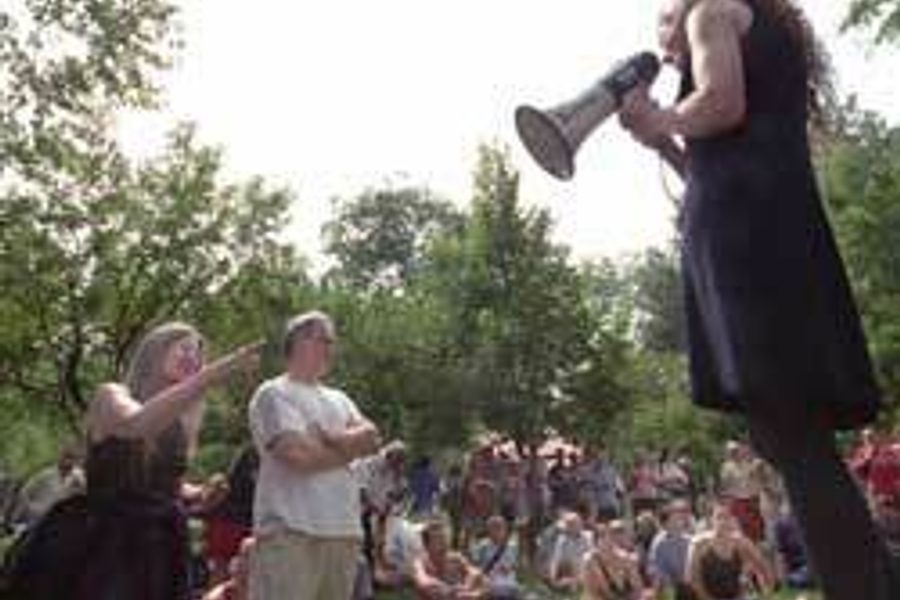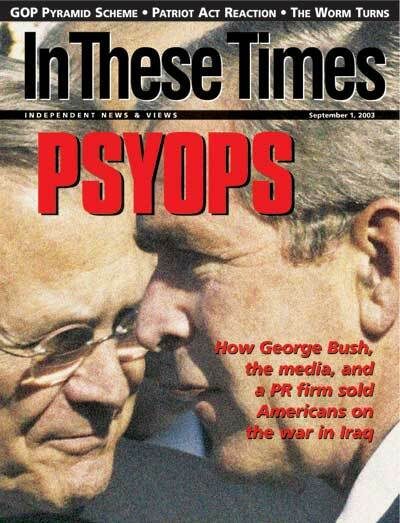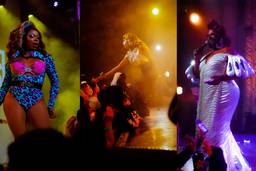
Today, the maps may read Washington Square Park, but for the better part of a century, this well-manicured plot of grass on Chicago’s Near North Side was once known as Bughouse Square, the city’s preeminent forum for free speech.
At Bughouse Square, all forms of human miscellany—from anarchists to academics, poets to prostitutes, crooks to clergymen—gathered round, mounted soapboxes, and pontificated on a myriad of political and philosophical issues. One Chicago newspaper described the square as “a three-ring circus, [or] a carnival. … You have a feeling, as you leave the square that you’d go bughouse if you stayed there any longer.”
On July 25 and 26, the Newberry Library held its annual Bughouse Square Debates in homage to the bedlam of yore. With megaphones in hand, a dozen orators expounded on Illinois gambling laws, the prison system, civil disobedience, weapons of mass destruction, the war in Iraq, genetically modified foods, union labor, the Patriot Act, and even the concept of depaving Lake Shore Drive.
Audiences did their part with cat calls and heckling, while the soapboxers responded with wit, passion, or sometimes just a blank stare. But Kathy Kelly, a three-year Bughouse participant and founder of the Chicago-based Voices in the Wilderness, subdued the jeering crowd with her sobering recollections of life in Baghdad during the war in Iraq.
————–
In its infancy in the mid-1800’s, Bughouse Square was a place where people would gather to get water, share stories, and wax poetic on the news and politics of the day. Then around 1900, as more immigrants moved to Chicago and the city expanded, the old-money mansions surrounding the square became rooming houses with a variety of vagabonds milling about.
“Around this time there was a very organized hobo movement in Chicago,” muses Cindy Mitchell, Bughouse historian and current “mayor” of Bughouse Square. “They would gather in the square and elect a king to decide who should speak, what they should speak about, and where the stage should be.” Bughouse Square gradually became the hub of a “new bohemian element” in town. By 1915, it was a bastion of unbridled free speech. Everyday new ideas were being experimented with, argued over, and discussed as old ones were being challenged, reconfigured, or blatantly disregarded.
“Nothing was too taboo or sacred, and no one was safe from the voices of dissent,” Mitchell says. Besides the usual mix of bohemian radicals, soapboxers also included fundamentalist Christians, doctors, prohibitionists, and the occasional raving lunatic.
“Two of the most famous Bughouse orators was a man called ‘One-Armed Charlie’ who would quote the Constitution by heart, and ‘Crazy Mary’ who was a religious fanatic,” recalls Mitchell. Ambassadors of free speech like Clarence Darrow, Ben Hecht, Carl Sandburg, Eugene Debs, and Emma Goldman all made Bughouse Square a regular stop. Around the corner, the Dill Pickle club took the debate indoors during the winter and was marked by a sign reading: “Step high, stoop low, leave your dignity outside.”
But Bughouse, like much of radical America, started to go into decline during World War I, when the police began cracking down on suspected radicals, anarchists, and socialists through harassment and bogus arrests. And with the rise of radio and television, it wasn’t long before the City of Big Shoulders shrugged off its oldest platform for free speech. With the exception of the yearly debates, these days the square is a shadow of its former self, with neither soapbox nor silver-tongued speaker in sight.
At Bughouse Square, all forms of human miscellany—from anarchists to academics, poets to prostitutes, crooks to clergymen—gathered round, mounted soapboxes, and pontificated on a myriad of political and philosophical issues. One Chicago newspaper described the square as “a three-ring circus, [or] a carnival. … You have a feeling, as you leave the square that you’d go bughouse if you stayed there any longer.”
On July 25 and 26, the Newberry Library held its annual Bughouse Square Debates in homage to the bedlam of yore. With megaphones in hand, a dozen orators expounded on Illinois gambling laws, the prison system, civil disobedience, weapons of mass destruction, the war in Iraq, genetically modified foods, union labor, the Patriot Act, and even the concept of depaving Lake Shore Drive.
Audiences did their part with cat calls and heckling, while the soapboxers responded with wit, passion, or sometimes just a blank stare. But Kathy Kelly, a three-year Bughouse participant and founder of the Chicago-based Voices in the Wilderness, subdued the jeering crowd with her sobering recollections of life in Baghdad during the war in Iraq.
————–
In its infancy in the mid-1800’s, Bughouse Square was a place where people would gather to get water, share stories, and wax poetic on the news and politics of the day. Then around 1900, as more immigrants moved to Chicago and the city expanded, the old-money mansions surrounding the square became rooming houses with a variety of vagabonds milling about.
“Around this time there was a very organized hobo movement in Chicago,” muses Cindy Mitchell, Bughouse historian and current “mayor” of Bughouse Square. “They would gather in the square and elect a king to decide who should speak, what they should speak about, and where the stage should be.” Bughouse Square gradually became the hub of a “new bohemian element” in town. By 1915, it was a bastion of unbridled free speech. Everyday new ideas were being experimented with, argued over, and discussed as old ones were being challenged, reconfigured, or blatantly disregarded.
“Nothing was too taboo or sacred, and no one was safe from the voices of dissent,” Mitchell says. Besides the usual mix of bohemian radicals, soapboxers also included fundamentalist Christians, doctors, prohibitionists, and the occasional raving lunatic.
“Two of the most famous Bughouse orators was a man called ‘One-Armed Charlie’ who would quote the Constitution by heart, and ‘Crazy Mary’ who was a religious fanatic,” recalls Mitchell. Ambassadors of free speech like Clarence Darrow, Ben Hecht, Carl Sandburg, Eugene Debs, and Emma Goldman all made Bughouse Square a regular stop. Around the corner, the Dill Pickle club took the debate indoors during the winter and was marked by a sign reading: “Step high, stoop low, leave your dignity outside.”
But Bughouse, like much of radical America, started to go into decline during World War I, when the police began cracking down on suspected radicals, anarchists, and socialists through harassment and bogus arrests. And with the rise of radio and television, it wasn’t long before the City of Big Shoulders shrugged off its oldest platform for free speech. With the exception of the yearly debates, these days the square is a shadow of its former self, with neither soapbox nor silver-tongued speaker in sight.





